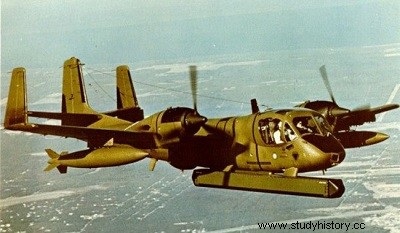
Aircraft:Grumman OV-1A Mohawk.
Manufacturer:Grumman Aircraft Engineering Corp.
Type:reconnaissance.
Year:1959
Engine:two Lycoming
T53-L-3 turboprop engines, 1,005 hp each.
Wingspan:12.80 m
Length:12.50 m.
Height:3.86 m.
Take-off weight:4,728 kg.
Maximum speed:510 km/h at 1,525m altitude.
Maximum operational altitude:10,670 m.
Range:2,700 km.
Armament:—
Crew:2 people.
Representing a very specific class of combat aircraft, the Grumman Mohawk was designed for a very specific job:front-line tactical observation. Very handy, fast, quite agile but above all endowed with exceptional STOL characteristics and a very robust structure, this small twin-engine turboprop remained in production for nearly ten years and all the examples made (more than 375), spread over four versions base, equipped detachments of the US Army. They served extensively in the Vietnam conflict and although engineers originally did not provide for the installation of armament, many of these aircraft underwent field modifications to be able to carry large quantities of weapons. offensive weapons, such as rockets, grenade launchers, rotary-barrel machine guns and small-sized missiles.
In 1957, the US Army and the US Marine Corps jointly launched the program with the intention of realizing a light advanced observation aircraft, capable of operating from unprepared terrain and performing short take-offs and landings. . The Grumman project won the competition and, in the same year, the construction of 9 pre-production examples began.
Initially called YAO-1AF, the first of these flew on April 14, 1959 and did not reveal any particular focusing problem. The aircraft was in the form of a medium-winged monoplane, equipped with two Lycoming T53 turboprop engines of 1,005 HP each which drove three-bladed metal propellers, and equipped with a fully retractable nose tricycle landing gear.
The engineers paid particular attention to the aerodynamic elements and control surfaces in order to maximize the aircraft's low-speed handling and STOL characteristics. The pilot and the observer were placed side by side in a cabin located at the very front, which provided them with excellent visibility. However, immediately after the start of the tests, the US Marine Corps abandoned the program and the US Army continued the development of the aircraft alone.
From then on, the technicians made the device taking into account only the requirements issued by the Army. This one ordered the production of three different versions the first, called AO-1AF, intended exclusively for the diurnal and nocturnal photographic reconnaissance; the second, the A0-1BF, fitted with a side-scan radar (SLAR) installed in an outer dome under the fuselage; the third, the A0-1CF, reserved for infrared recognition.
These versions changed their name from 1962 and carried the acronyms OV-1A, OV-18 and OV-1C respectively. Subsequently, the Americans developed a fourth model, the 0 V- /D, which combined the operational characteristics of the OV-113 and the OV-1C:a rapid transformation allowed these machines to be used both for reconnaissance and for radar sighting. Thanks to this special equipment, a permanent photographic map of the terrain overflown by the plane was obtained, which proved very useful during the missions carried out in Southeast Asia.
The production of the Mohawk continued until December 1970. Driven by the desire to provide it with increasingly greater operational possibilities and to adapt them to the constant evolution of electronics, the Americans modernized the planes of the different versions and in particular modified the on-board equipment.
